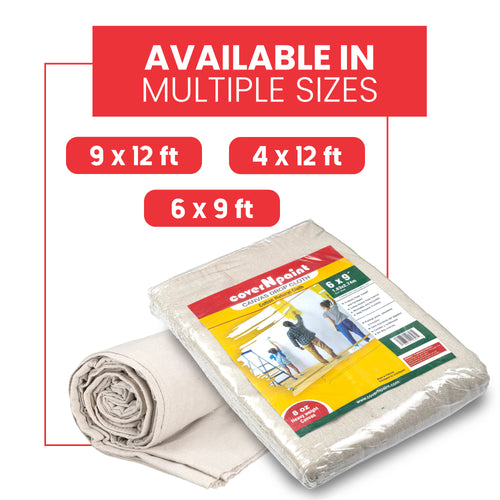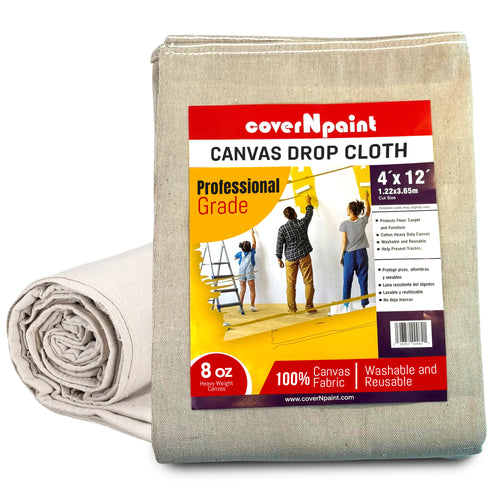Painting may be a dirty project, whether you're painting a whole room or just a small spot here and there. A Painters Drop Cloth is one basic item that every painter has to have in their toolbox. However, what is a drop cloth precisely, and why is it so crucial? We'll cover all you need to know about drop cloths for painters in this extensive guide, including types, uses, and advice on selecting the best one for your job.
The Purpose of a Drop Cloth
A drop cloth is a protective covering used by painters to safeguard floors, furniture, and other surfaces from paint splatters, spills, and drips. Its primary purpose is to prevent damage and make cleanup easier after painting. By creating a barrier between the painted surfaces and the surrounding areas, drop cloths help maintain cleanliness and preserve the condition of floors and furnishings.
Types of Drop Cloths
Drop cloths come in various materials, each offering different levels of protection and suitability for specific painting projects:
Canvas Drop Cloths
Canvas drop cloths are highly durable and reusable. Made from heavy-duty cotton or cotton-polyester blends, they are thick and provide excellent protection against paint spills. Canvas drop cloths are ideal for long-term projects or when heavy traffic is expected on the covered surfaces.
Plastic or Polyethylene Drop Cloths
Plastic or polyethylene drop cloths are lightweight, inexpensive, and disposable. They offer good protection against paint spills but are more prone to tearing compared to canvas. Plastic drop cloths are convenient for short-term projects or when quick cleanup is desired.
Paper or Cardboard Drop Cloths
Paper or cardboard drop cloths are economical and disposable options. They provide basic protection against paint drips but are less durable compared to canvas or plastic. Paper drop cloths are suitable for smaller projects or as supplementary protection in addition to other drop cloths.
Non-Woven Drop Cloths
Non-woven drop cloths are made from synthetic materials such as polyester or rayon. They offer a balance between durability and cost-effectiveness, providing moderate protection against paint spills. Non-woven drop cloths are lightweight and easy to maneuver, making them suitable for a wide range of painting projects.
Choose CoverNpaint for Drop Cloth
CoverNpaint is a reputable source for painters looking for premium canvas drop cloths in the United States. CoverNpaint, a company well-known for its dependability and durability, has a selection of canvas drop cloths that are perfect for both novice and experienced painters. Their products offer better protection against paint drips and spills since they are made of heavy-duty cotton or cotton-polyester blends.
Benefits of Using a Drop Cloth
Using a drop cloth offers several advantages for painters:
· Protects Surfaces:
Prevents paint from dripping or spilling onto floors, carpets, furniture, and other surfaces.
· Easy Cleanup:
Reduces the time and effort required for post-painting cleanup.
· Cost-Effective:
Helps avoid costly damage to floors and furnishings.
· Versatility:
Can be used indoors or outdoors, on various surfaces such as wood, tile, concrete, and carpet.

How to Choose the Right Drop Cloth
Selecting the appropriate drop cloth depends on several factors, including the type of project, level of protection needed, and budget:
Project Size and Duration
Consider the size of the area you need to cover and the duration of the painting project. For large projects or extended periods, a durable canvas drop cloth may be more suitable. Smaller projects or short-term jobs may require a less expensive option like plastic or paper drop cloths.
Surface Type
Different surfaces may require different levels of protection. For delicate surfaces like hardwood floors or expensive carpets, a thicker and more absorbent drop cloth such as canvas is preferable to prevent damage from paint spills.
Reusability
Canvas drop cloths are reusable and can withstand multiple uses with proper care. If you anticipate frequent painting projects, investing in a canvas drop cloth may be more cost-effective in the long run compared to disposable options like plastic or paper.
Budget
Your budget will also influence your choice of drop cloth. While canvas drop cloths are more expensive initially, their durability and reusability make them a cost-effective option over time. Plastic and paper drop cloths are more affordable for one-time or occasional use.
Tips for Using Drop Cloths Effectively
To maximize the benefits of using a drop cloth and ensure a successful painting project, follow these tips:
Secure the Drop Cloth:
Use painter's tape or heavy objects to secure the drop cloth in place and prevent it from shifting during painting.
Overlap Seams:
When using multiple drop cloths, overlap the seams to create a seamless barrier and prevent paint from seeping through the gaps.
Cover Entire Area:
Extend the drop cloth to cover the entire surface area where paint may drip or spill, including adjacent walls and furniture.
Inspect Regularly:
Periodically check the drop cloth during painting to ensure it remains in place and effectively protects surfaces from paint splatters.
Dispose Properly:
If using disposable drop cloths, dispose of them responsibly after use to minimize environmental impact.
Maintaining and Caring for Drop Cloths
Once your painting project is complete, proper care and maintenance of your drop cloths are crucial to ensure their longevity and effectiveness for future use. Here’s how you can care for different types of drop cloths:
Canvas Drop Cloths:
Canvas drop cloths are durable and designed for repeated use. After each use, shake off any excess paint and allow the drop cloth to dry completely. If necessary, you can vacuum or brush off dried paint residues. For heavier stains, spot clean with mild soap and water. Allow the drop cloth to air dry thoroughly before folding and storing it in a clean, dry place.
Plastic or Polyethylene Drop Cloths:
Plastic drop cloths are typically disposable but can be reused if they remain intact and free of significant paint buildup. After use, carefully fold or roll the drop cloth to contain any paint residues. Dispose of heavily soiled drop cloths responsibly, considering environmental impact.
Paper or Cardboard Drop Cloths:
Paper drop cloths are meant for single-use and should be disposed of after each painting project. Fold or roll the drop cloth to contain paint residues and dispose of it in accordance with local waste disposal regulations.
Alternatives to Traditional Drop Cloths
While traditional drop cloths are effective, there are alternative methods and materials that painters can use to protect surfaces during painting:
Painter’s Tape and Plastic Sheeting:
Painter’s tape can be applied to edges and surfaces where paint splatter is likely. Combine with plastic sheeting to create a makeshift barrier for furniture and floors.
Old Sheets or Bedding:
Repurpose old sheets or bedding as drop cloths. While not as durable as traditional drop cloths, they can provide basic protection and are easily washable.
Floor and Surface Protectors:
Specialized floor and surface protectors, such as adhesive films or reusable mats, offer targeted protection for specific areas during painting.
Common Mistakes When Using Drop Cloths
Even with the best intentions, painters can sometimes make mistakes when using drop cloths. Here are some common pitfalls to avoid:
Insufficient Coverage:
Failing to extend drop cloths far enough beyond the painting area can result in paint spills or drips reaching unprotected surfaces.
Poor Securing:
Inadequately securing drop cloths with tape or weights can cause them to shift during painting, leaving surfaces vulnerable to paint damage.
Neglecting Cleanup:
Not cleaning or disposing of drop cloths promptly after use can lead to hardened paint residues that are difficult to remove, diminishing the drop cloth’s effectiveness over time.
Innovations in Drop Cloth Technology
As painting techniques and materials evolve, so do innovations in drop cloth technology. Some advancements include:
Absorbent Barrier Layers:
Drop cloths with absorbent layers help trap paint spills and prevent them from seeping through to underlying surfaces.
Anti-Slip Backings:
Drop cloths designed with anti-slip backings enhance stability and reduce the likelihood of accidental slips or trips during painting.
As a result, artists of all experience levels should always have a drop cloth on hand. Drop cloths assist maintain cleanliness and preserve the condition of floors, furniture, and other surfaces by acting as a barrier against paint spills and drips. To choose the best drop cloth for your purposes, take into account variables including the type of material, project size, surface sensitivity, and budget. Using a drop cloth will expedite your painting process and guarantee professional-quality results, regardless of whether you choose a long-lasting canvas drop cloth or a handy disposable option.













